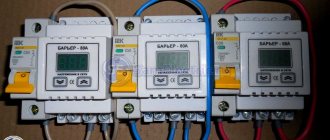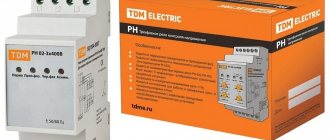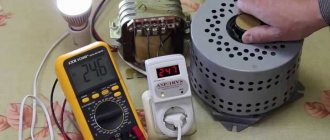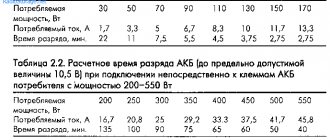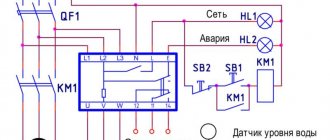Those houses that are connected to old power lines are acutely affected by power surges in the network. Due to such violations, household appliances often break down. The problem can be solved by simply installing a voltage relay. Let's analyze what such a device is and how to choose it wisely. We’ll also figure out how to connect the device to your home network.
Control device in a niche Source hsto.org
Why do you need to control voltage?
The device has an official name - voltage control relay. But the middle word is often discarded. And professionals often call the device among themselves “zero break protection.” After all, it falls into the category of protective automation. Let's figure out why we need a voltage relay.
The average consumer is accustomed to the fact that all electrical appliances are powered from a network whose voltage is 220 V. In fact, the voltage variation in the outlet is allowed with a plus or minus of 10 units. And all household equipment is produced so that it can work with a reserve. That is, in the range from 170 to 265 V.
But worn-out electrical networks sometimes produce spikes of up to 380 volts. Or they experience a voltage drop of up to 70 units. In both cases, nothing good happens. With an extreme instantaneous increase in parameters, in houses equipped with automatic protective equipment, the fuses will simply blow out. And if the latter are absent, then the action scenario can go in two ways.
Burnt fuse Source p-advice.com
Fuses will blow if there are any in a working TV, computer or microwave. In their absence, any device is guaranteed to fail if it was used at that moment. Moreover, it could easily catch fire. And this is already fraught with a fire in the house.
It would seem that too low voltage in the network cannot threaten anything terrible. Well, the light bulb in the lamp will burn dimly. Or the iron will not heat up and things will remain unironed. But this is not true.
First of all, all household appliances that have a compressor will suffer. The latter simply will not start at low voltage. This is fraught with the fact that the electric motors of the equipment quickly begin to overheat. And having reached a critical state, they completely fail.
See also: Catalog of companies that specialize in complex installation of internal engineering systems
Causes of problems
There are three factors that cause voltage drop:
- When the phase is shorted to neutral, 380 Volts will appear in the socket.
- If a zero break occurs and the load in the network is low, then the voltage will sharply tend to the peak.
- There may be a voltage imbalance in the phases.
Low voltage Source uk-parkovaya.ru
In the latter case, an unevenly distributed load leads to the fact that the busiest line will suffer. The voltage will drop to critical. And this is fraught with local problems in the technology itself. And, as a rule, if there is no surge protection relay on the line, then the refrigerator or air conditioner will be the first to suffer.
In rare cases, electricians are to blame for a zero break. The wire can be damaged due to inexperience and carelessness. More often the latter fades away from old age. The provided protection will de-energize the line and disastrous consequences will not occur. There will be temporary inconvenience until the network is restored.
But, if there is no voltage cut-off, then a real mess ensues in the house. In some rooms, the voltage in sockets drops to 50-100 units. In other apartments it rises sharply to 300-350. Moreover, the result is completely local and depends on the specific load on the home line.
A sharp increase in voltage Source uk-parkovaya.ru
As a result, some owners' household equipment simply stops working. Those less fortunate will have to take it for repairs. But after a critical power surge, it happens that repairing the device becomes unprofitable. And then all that remains is to buy a new one. And, as a rule, there is no one to file a claim with.
How protection works
The operating principle of a voltage relay is simple. The device has a built-in network load monitoring unit. Control parameters are usually set by the manufacturer. But the owner has the right to set his own limits.
The block is constantly busy measuring the voltage on the line. And if it deviates from the norm in any direction, then a signal is instantly sent to the executive module. The latter immediately switches off the load on the line, saving working devices.
But the measuring unit continues to operate in cyclic mode. After a certain period of time, the module takes readings from the line. If violations persist, then the automation is inactive. She waits for the next time period for measurements.
Voltage monitoring device Source prom.st
It can also be installed manually. Or leave the factory settings. When the measurements show the specified norm, the executive unit is also notified about this. And it closes the power contact, renewing the connection to external power sources.
Bottom line
The internal design of the EZ9C1240 voltage relay from the Easy 9 line is designed for long and trouble-free operation. In particular, all relays have flexible connectors inside them, which have a number of advantages over other types of electrical connections. The fact is that the relay is a maintenance-free device, and all internal connections are made using spot welding, the quality and reliability of which directly affects the service life of the product.
It is the flexible connection that allows you to get the most reliable contact, which is also not subject to mechanical stress because such a connection is made with a margin of length. In addition, flexible connections are more resistant to vibrations that inevitably occur during the operation of electrical equipment.
For this reason, this type of connection is used almost everywhere in electrical equipment, for example, in modular circuit breakers and differential devices of any manufacturer, in molded circuit breakers up to 630 A and even in medium voltage equipment 6-10 kV (for example, Evolis circuit breaker from Schneider Electric). A voltage relay is installed at the entrance to the electrical panel, immediately after the input circuit breaker.
Selection of protective automation
Overvoltage relays can be classified according to three criteria. Pay attention to the location and dimensions. Take into account the capabilities of the device. As well as the number of phases in the electrical network. Due to these indicators, the installation of the device differs in many ways.
And when choosing protective automation, people usually pay attention to:
- operating range in volts;
- maximum power;
- passing current;
- speed of network shutdown when an alarm signal is given;
- delay before re-supplying electricity;
- presence of indication.
An important factor is the presence of manual settings. Many apartment owners are not satisfied with the parameters set by manufacturers. And they would like to independently set the upper and lower thresholds for triggering the automation.
Adjustable voltage control relay Source prom.st
Phasing
Since the power supply system may differ, the devices are divided into single-phase voltage control relays and three-phase ones. Apartments and most private cottages are equipped first. They work with networks with a voltage of 220 V.
Three-phase protection is mainly used in industry. For example, they protect machines that use several phases for their operation. Moreover, in some cases, phase synchronization is additionally controlled.
Three-phase relays are also used in private homes if the voltage circuit has 380 Volts. But the device has a feature that has a negative effect when used at home. The protection is triggered if oscillation occurs in any of the three phases, which is not critical on a private line. But for production, such a safety net is often a plus. Although in many cases you can easily do without it.
The difference between a three-phase relay and a single-phase one
Devices designed for connection to a three-phase network have expanded functionality compared to single-phase devices. When protecting 3-phase electrical equipment, in addition to monitoring the supply voltage level, the following parameters are additionally monitored:
- symmetry of the three-phase power system;
- open circuit (break) of the neutral wire, in which line voltages remain normal and phase voltages are absent;
- phase rotation order;
- Some types of relays have a function for monitoring the frequency of the supply network.
By symmetry of a three-phase system we mean equality of frequency and voltage amplitude in all phases and a phase shift between them of 120°.
Symmetry control is carried out by constantly comparing the vector difference of phase voltages.
The presence of a symmetry factor is important for the proper operation of 3-phase equipment - electric motors, transformers. An extreme case of asymmetrical mode occurs when one or two supply phases break.
Operation of motors in a 380 volt network in open-phase mode is not allowed, as this leads to damage to their windings. StabExpert.ru reminds that the danger of such a regime is aggravated by the fact that in this case current protections usually do not work.
Example:
Working on two phases, a three-phase motor consumes a current that barely exceeds the rated current, but it does not pick up speed, the windings overheat and burn out.
Violation of the phase sequence entails reverse (that is, directed in the opposite direction) rotation of electric motors, which leads, at a minimum, to incorrect operation of the mechanisms, disruption of the technological process, and even damage to installations. This type of eating disorder can occur in two cases:
- incorrect connection of phases in the distribution cabinet or at the electric motor terminals, carried out by the consumer himself;
- an error by network enterprise personnel, which can occur, for example, when connecting cable inputs in substation switchgears after repairs.
Therefore, install an appropriate stabilizer that will monitor the “skew” of parameters, or a three-phase voltage relay with phase control (review of models below). We have a separate article on how to choose a 380V voltage stabilizer for your home.
As for the frequency of the power supply network, there are mainly two reasons for its change:
- 1. A decrease in frequency can be observed in regions with a shortage of generated active power, in other words, when the total load of consumers exceeds the power generated by stations. In some regions, this violation is systemic and long-lasting.
- 2. An increase in frequency is observed less frequently, for example, during short-term “surges” of power, which usually occur when powerful high-voltage power lines are turned off. At these moments, an excess of power generated by power plant generators appears, which is very quickly eliminated by the action of system automation, so the consumer is not particularly worried.
Whether to disconnect from the mains when the frequency changes is up to the consumer to decide; it depends on how critical his equipment is to such changes.
The voltage relay control circuits must be permanently connected to the mains supply and when the load is disconnected, they must not be turned off along with it. This is understandable, because if you connect the control circuits after the contacts of the executive relay, then at the first disconnection the control will be lost and automatic reconnection will not occur.
Video description
The video will show how a single-phase voltage relay works, which one is better to choose based on the test results:
Device dimensions
All products are divided into 3 types:
- Adapter for one socket. Protects only one device connected through it.
- An extension cord where there can be from one to six sockets. In this case, the protection extends to an entire group of devices.
- Bag holder for DIN rail. It is mounted in a common electrical panel and controls the entire electrical supply system of the apartment.
The latest version of a 220 V voltage relay for the home is not only the most functional. It is also the most suitable in terms of design, since all devices are hidden from view. And the devices from the first two points most often have large sizes. And most often it is not possible to make them more compact so that they do not spoil the interior of the home.
Basics and additional features
In most modern protective automatic equipment, voltage control is carried out by a microprocessor. Cheap analogues of relays operate on the basis of a conventional comparator. The microprocessor allows for precise adjustment of the device. Including stepless manual adjustment for response thresholds.
Surge protection device Source psk-remont.ru
Also, devices may have different indications. In simple designs, only a pair of LEDs are built in, which indicate the voltage at the output and input. All modern models have a display on the body that shows the voltage. It can also show specified response thresholds.
Setting modes
Relay settings buttons
Threshold values of the RKN are set using several potentiometers on a graduated scale placed together with knobs on the front panel.
In some samples, buttons are used to set response limits.
The step with which the lower and upper limits are set for most RKN samples is one Volt. The correct setting of the required parameter is controlled by the indicator board located on the front panel of the device.
On some models, there is another regulator that sets the time for the device to return to its original state, the moment when the load is reconnected to the power circuit. It can be set in a wide range of values from several seconds to 10 minutes.
Available connection diagrams
In the panel, a single-phase voltage relay is mounted after the meter. It must be placed in the break of the phase wire. Because only the device should control the voltage. And cut off the phase if necessary.
There are two connection diagrams. It is more common to install relays under direct load. But you can connect an additional magnetic contactor to it. When installing the device, the main thing is not to confuse the connection of wires to the input and output. True, this is difficult to do, since there are only three terminals on the automation body, and they are all labeled - input, zero, output.
Devices with different rated power are available for sale. Therefore, there will be no problems in selecting the right one for your home network. But it is always possible to install several low-power relays using a parallel circuit. In this case, only its own group of electrical appliances is connected to each controller.
How to set up devices
The simplest designs have preset response thresholds set by default by the manufacturer. As a rule, the operating range of the relay is from 170 to 265 V. The parameters may differ, so when choosing, you need to pay attention to them, since it will not be possible to reconfigure later.
Adjustable relays have 3 settings:
- The lower threshold for triggering is set.
- The maximum voltage value is selected.
- Sets the delay period before turning on again.
Connecting a voltage relay is a serious process. But setup requires even more responsibility. It is necessary to study all the household equipment used in the house. And only then set the thresholds. As for turn-on delays, a compromise will have to be found there.
If appliances with a compressor (refrigerator, air conditioner) have priority in protection, then the voltage re-supply time must be set to quite long. From a couple of minutes. And in some cases even bring it to five. This will protect the devices from sudden voltage surges.
Extension cord with controller Source prom.st
But if only a TV and a computer are protected, then a delay of only 10-20 seconds is sufficient. For adjustments, smooth regulators are provided on the body. Modern devices are equipped with convenient sensors.
Some experts recommend connecting a voltage stabilizer rather than a control relay. This is motivated by the fact that in addition to the functions of the latter, it also equalizes the voltage. Therefore, more reliable protection is obtained.
But the stabilizer has significant disadvantages:
- It makes noise when working.
- Takes up a lot of space due to its bulkiness.
- Does not allow fine tuning.
- Increases the network current and thereby creates a danger for unprepared wiring.
- If the grounding is broken, the voltage surge remains unattended.
- Its cost is much higher than a conventional relay.
Therefore, they are accustomed to using a voltage stabilizer only locally. For example, to protect only one refrigerator.
Advantages and disadvantages of stabilizers
The advantages of a stabilizer include the ability to equalize voltage. The most advanced devices of this type (inverter class) maintain the specified parameter with a deviation of no more than 1%. But even the cheapest stabilizer models will not allow deviations of more than 5%. Of course, this mode is most favorable for electrical appliances and can extend their service life.
Stabilizers have high efficiency. Another plus is the minimal impact on the quality of the analog signal. It is easy to connect stabilizers to the network, so there is no need to invite a specialist to install this protective device.
But there are also disadvantages. Stabilizers are quite large in size, and the most powerful models make noticeable noise and heat up during operation. The cost of these devices is also quite significant.
The individual use of stabilizers allows you to compensate for shortcomings. Devices for connecting loads up to 1.5 kW remain relatively compact and affordable, which cannot be said about models designed for loads of 3 kW or more.
Briefly about the main thing
To protect home equipment from network overloads, it is necessary to install protective automatic equipment in it. You can use a regular relay that will control the voltage. The device will constantly measure the readings of the latter. And if you deviate from the set norm, independently disconnect from the power source.
You can provide protection to each individually connected household device. For this, special adapters and extensions are produced. But it is more reasonable to protect the entire home electrical network from overvoltage by installing one relay directly in the apartment’s electrical panel.
Connecting the automation is simple. The relay is installed immediately after the meter, breaking the phase wire. The main attention is paid to setting up the device. Reliable protection will be provided by setting upper and lower response thresholds. As well as the delay time before turning on again.


